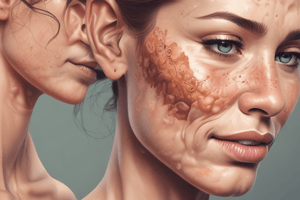Podcast
Questions and Answers
What is the primary focus of the differential diagnosis of a rash in a young adult?
What is the primary focus of the differential diagnosis of a rash in a young adult?
- Distribution of the lesions
- Global reaction pattern
- Morphology of the lesion (correct)
- Size of the lesion
What is the definition of a primary lesion?
What is the definition of a primary lesion?
- An initial lesion that has not been altered by trauma or manipulation, and has not regressed (correct)
- A lesion that has been altered by trauma or manipulation
- A lesion that contains pus
- A lesion that has regressed
What is a bulla?
What is a bulla?
- A circumscribed, nonpalpable discolouration of the skin
- A circumscribed, elevated lesion that measures ≥ 1 cm and contains serous or hemorrhagic fluid (correct)
- A lesion that contains pus
- A small, elevated lesion
What is the difference between a primary and secondary lesion?
What is the difference between a primary and secondary lesion?
What is the term for the overall pattern of the skin's response to a rash?
What is the term for the overall pattern of the skin's response to a rash?
What is a macule?
What is a macule?
What is a vesicle?
What is a vesicle?
What is the correct order of steps in constructing a differential diagnosis for a rash in a young adult?
What is the correct order of steps in constructing a differential diagnosis for a rash in a young adult?
What is the definition of a rash?
What is the definition of a rash?
Flashcards are hidden until you start studying
Study Notes
Differential Diagnosis of a Rash in a Young Adult
- A rash is an inflammatory skin eruption.
- Differential diagnosis of a rash is primarily based on the morphology of the lesion.
Primary and Secondary Lesions
- Primary lesion: the initial lesion that has not been altered by trauma or manipulation and has not regressed.
- Secondary lesion: develops as the disease evolves or as the patient damages the lesion (e.g., rubbing, scratching, infections).
Types of Primary Lesions
- Bulla: a circumscribed, elevated lesion that measures ≥ 1 cm and contains serous or hemorrhagic fluid (i.e., a large blister).
- Macule: a circumscribed, nonpalpable discoloration of the skin that measures ≤ 0.3 cm.
- Pustule: a lesion that contains pus; may be follicular (centered around a hair follicle) or nonfollicular.
- Vesicle: a circumscribed, elevated lesion that measures < 1 cm.
Steps in Constructing a Differential Diagnosis
- Identify the primary lesion, which is the typical element of the eruption.
- Determine the global reaction pattern.
- Note the distribution of the lesions (e.g., diffuse, isolated, localized, regional, universal).
Studying That Suits You
Use AI to generate personalized quizzes and flashcards to suit your learning preferences.




